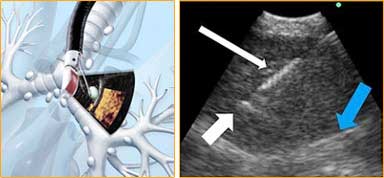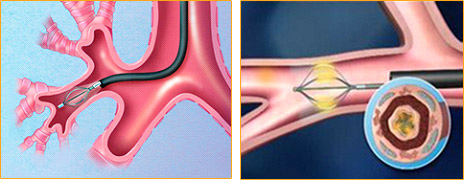Procedures
List of medical and surgical procedures performed by Pulmonary and Sleep Physicians of Houston, PA.
Ultrasound visualization is a recent improvement to bronchoscopy.
We can now see lymph nodes around the trachea and major bronchi
and take aspiration samples with accuracy. This is done to
improve accuracy of staging of lung cancer, to choose the
most appropriate therapy. This may spare the patient from
more invasive procedures like mediastinoscopy.

For most people, asthma can be controlled with medication. But for the 5%-10% of asthmatics whose condition is severe, breathing is difficult, even with a doctor's help. For those who don't respond to traditional therapy, bronchial thermoplasty is now available. It's breakthrough treatment that applies radiofrequency energy that has been used successfully in other medical treatments.

Ultrasound Bronchoscopy:
Ultrasound
visualization is a recent improvement to bronchoscopy.
We can now see lymph nodes around the trachea and major
bronchi and take aspiration samples with accuracy. This
is done to improve accuracy of staging of lung cancer,
to choose the most appropriate therapy. This may spare
the patient from more invasive procedures like mediastinoscopy.
PURPOSE:
To
examine the upper and lower airways including the lungs.
DESCRIPTION:
It
is an examination in which the lining of the throat, voice
box and the Bronchi inside the lungs are examined by direct
vision through a small flexible instrument called a Bronchoscope.
The instrument looks like a small hose through which light
is passed. Biopsies or cultures can be taken through the
Bronchoscope.
PREPARATION:
- You should not eat or drink anything after midnight if the procedure is done before noon.
- If the procedure is scheduled in the afternoon, a light
liquid breakfast is allowed: you should not eat or drink
after
your liquid breakfast. - If you are a smoker, smoking should be avoided at least twenty four (24) hours before the day the procedure is scheduled.
- You must sign an Informed Consent Form for the procedure acknowledging possible risks.
- Notify your physician regarding medications that are used regularly by you. Eg. Insulin, blood pressure or heart medication, etc. The drugs may be held or dose modified at the direction of the physician.
- You will be required to remove your dentures or partial plates.
- Your doctor will require an I.V. or Heparin Lock inserted in an arm vein on the morning of the procedure; this will be discontinued at the direction of the physician.
- You will be given a pre-medication consisting of one or more drugs about 30 minutes prior to the procedure by an intramuscular injection; this will dry up your secretions and provide mild sedation: your throat may feel dry and you may feel sleepy.
- You will change into a hospital gown.
- The nurse will connect you to a monitor to observe your heart beat and rhythm and to measure your blood pressure prior to and during the procedure.
- You will be questioned about drug allergies.
- Oxygen may be given via your nostrils at the discretion of your physician.
PROCEDURE:
- At the beginning your nose and throat will be sprayed with local anesthetic till your throat feels numb and you no longer gag.
- Your nostrils will be lubricated with a local anesthetic cream to deaden the mucous membrane.
- You will be asked to either sit up or lie on your back during the procedure.
- The instrument will be passed carefully via one of your nostrils and past your throat and vocal cords into Bronchi (Lungs); along the way the mucous membrane will be sprayed with a local anesthetic to prevent coughing; sedatives may be given via I.V. to suppress cough and provide added sedation.
- During the procedure do not attempt to talk.
- Raise your hand to signal any discomfort or weariness during this procedure.
- Biopsies and brushing of the mucous membrane will be done as required. Biopsy is removal of a small piece of tissue and no pain will be felt. Biopsy is done under direct vision or under x-ray (fluoroscopy) guidance.
- Saline may be injected to clear any secretions and to wash away expected small bleeding spots during biopsy.
- Photographs may be taken through the instrument at the discretion of the physician.
SPECIAL INSTRUCTIONS:
- You should not eat for at least two (2) hours after the procedure.
- You are advised to rest for twelve (12) to twenty-four (24) hours after the procedure before resuming normal activity or as ordered by your physician.
- Some throat soreness is normal. Mild fever is normal. Use tylenol as needed. Coughing up blood tinged sputum is normal. Call your physician if amount of blood increases to more than a teaspoon at a time. Call your doctor for chest pain or shortness of breath. If your doctor can not be reached promptly, go to the emergency room.
A Pulmonary Function Test is a non-invasive breathing test, performed in the office, to measure lung function and capacity.
What is the Endobronchial Valve Placement for emphysema ®
Valve:
The
first FDA-approved, minimally-invasive device available
in the U.S. for treating patients with severe emphysema.
Who is the Zephyr® Valve for?
Severe
emphysema patients who consistently feel short of breath
despite using COPD medications and/or oxygen.
Laser Ablation, Rigid Bronchoscopy, and Bronchial and tracheal stent placement.
